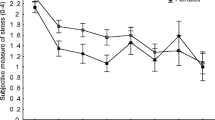Abstract
Individuals often respond to threatening situations in consistently different ways and these differences may predict later translocation success. Thus, the ability to easily identify these differences prior to translocation may assist in improving conservation outcomes. We asked whether burrowing bettongs (Bettongia lesueur), a marsupial species that has undergone significant decline since the introduction of exotic predators to Australia, responded in consistently different ways to capture in traps, and if so, whether this was related to anti-predator behaviour, ranging behaviour and survival following translocation. Behavioural responses of 40 bettongs were measured and included response to removal from traps (trap docility), latency to leave a trap or bag and escape behaviour upon release. We used flight initiation distance to measure escape behaviour, and distance moved from diurnal refuges during nocturnal foraging to measure ranging behaviour. Survival was measured through radiotracking after release. Behaviours scored during removal from a trap were consistent and repeatable, and formed a behavioural syndrome with anti-predator and ranging behaviour. Less docile bettongs foraged closer to refuges and had longer flight initiation distances. Less docile bettongs were also more likely to survive after release, although the sample size of mortalities was small. Our results suggest that behaviours scored during trapping could be a useful metric for pre-release screening in translocation programs to enhance the chances of individual survival post-release.


Similar content being viewed by others
References
Atkins R, Blumstein DT, Moseby KE, West R, Hyatt M, Letnic M (2016) Deep evolutionary experience explains mammalian responses to predators. Behav Ecol Sociobiol 70(10):1755–1763
Banks PB, Hume ID, Crowe O (1999) Behavioural, morphological and dietary response of rabbits to predation risk from foxes. Oikos 85:247–256
Bannister HL, Lynch CE, Moseby KE (2016) Predator swamping and supplementary feeding do not improve reintroduction success for a threatened Australian mammal, Bettongia lesueur. Aust Mammal 38(2):177–187
Bates D, Maechler M, Bolker B, Walker S (2014) lme4: Linear mixed-effects models using Eigen and S4. R Package Version 1(7):1–23
Blumstein DT, Daniel JC (2005) The loss of anti-predator behaviour following isolation on islands. Proc R Soc Lond B 272(1573):1663–1668
Blumstein D, Holland BD, Daniel J (2006) Predator discrimination and ‘personality’in captive Vancouver Island marmots (Marmota vancouverensis). Anim Conserv 9(3):274–282
Bonnot N, Verheyden H, Blanchard P, Cote J, Debeffe L, Cargnelutti B, Klein F, Hewison AM, Morellet N (2014) Interindividual variability in habitat use: evidence for a risk management syndrome in roe deer? Behav Ecol 26(1):105–114
Boon AK, Réale D, Boutin S (2008) Personality, habitat use, and their consequences for survival in North American red squirrels Tamiasciurus hudsonicus. Oikos 117(9):1321–1328
Boyer N, Réale D, Marmet J, Pisanu B, Chapuis JL (2010) Personality, space use and tick load in an introduced population of Siberian chipmunks Tamias sibiricus. J Anim Ecol 79(3):538–547
Bremner-Harrison S, Prodohl P, Elwood RW (2004) Behavioural trait assessment as a release criterion: boldness predicts early death in a reintroduction programme of captive-bred swift fox (Vulpes velox). Anim Conserv 7(3):313–320
Cooper WE, Blumstein DT (2015) Escaping from predators: an integrative view of escape decisions. Cambridge University Press, Cambridge
Cooper WE, Pyron RA, Garland T (2014) Island tameness: living on islands reduces flight initiation distance. Proc R Soc Lond B 281(1777):20133019
Crainiceanu CM, Ruppert D (2004) Likelihood ratio tests in linear mixed models with one variance component. J R Stat Soc 66(1):165–185
Dingemanse NJ, Both C, Van Noordwijk AJ, Rutten AL, Drent PJ (2003) Natal dispersal and personalities in great tits (Parus major). Proc R Soc Lond 270(1516):741–747
Dingemanse NJ, Kazem AJ, Réale D, Wright J (2010) Behavioural reaction norms: animal personality meets individual plasticity. Trends Ecol Evol 25(2):81–89
Fischer J, Lindenmayer DB (2000) An assessment of the published results of animal relocations. Biol Cons 96(1):1–11
Fucikova E, Drent PJ, Smits N, Van Oers K (2009) Handling stress as a measurement of personality in great tit nestlings (Parus major). Ethology 115(4):366–374
Haage M, Maran T, Bergvall UA, Elmhagen B, Angerbjörn A (2016) The influence of spatiotemporal conditions and personality on survival in reintroductions–evolutionary implications. Oecologia 183(1):45–56
Kuznetsova A, Brockhoff PB, Christensen RHB (2017) lmerTest package: tests in linear mixed effects models. J Stat Softw 82(13):1–26. https://doi.org/10.18637/jss.v082.i13
May TM, Page MJ, Fleming PA (2016) Predicting survivors: animal temperament and translocation. Behav Ecol 27(4):969–977
Monclús R, Anderson AM, Blumstein DT (2015) Do yellow-bellied marmots perceive enhanced predation risk when they are farther from safety? An experimental study. Ethology 121(9):831–839
Montiglio P-O, Garant D, Pelletier F, Réale D (2012) Personality differences are related to long-term stress reactivity in a population of wild eastern chipmunks, Tamias striatus. Anim Behav 84(4):1071–1079
Moseby K, Read J, Paton D, Copley P, Hill B, Crisp H (2011) Predation determines the outcome of 10 reintroduction attempts in arid South Australia. Biol Conserv 144(12):2863–2872
Moseby KE, Blumstein DT, Letnic M (2016) Harnessing natural selection to tackle the problem of prey naïveté. Evol Appl 9(2):334–343
Nakagawa S, Schielzeth H (2010) Repeatability for Gaussian and non-Gaussian data: a practical guide for biologists. Biol Rev 85(4):935–956
Petelle MB, McCoy DE, Alejandro V, Martin JG, Blumstein DT (2013) Development of boldness and docility in yellow-bellied marmots. Anim Behav 86(6):1147–1154
Raudenbush SW, Bryk AS (2002) Hierarchical linear models: applications and data analysis methods. Sage, Thousand Oaks
Réale D, Gallant BY, Leblanc M, Festa-Bianchet M (2000) Consistency of temperament in bighorn ewes and correlates with behaviour and life history. Anim Behav 60(5):589–597
Réale D, Reader SM, Sol D, McDougall PT, Dingemanse NJ (2007) Integrating animal temperament within ecology and evolution. Biol Rev 82(2):291–318
Réale D, Martin J, Coltman D, Poissant J, Festa-Bianchet M (2009) Male personality, life-history strategies and reproductive success in a promiscuous mammal. J Evol Biol 22(8):1599–1607
Richardson K, Ewen J, Brekke P, Doerr L, Parker K, Armstrong D (2016) Behaviour during handling predicts male natal dispersal distances in an establishing reintroduced hihi (Notiomystis cincta) population. Anim Conserv 20(2):135–143
Robley AJ, Short J, Bradley S (2001) Dietary overlap between the burrowing bettong (Bettongia lesueur) and the European rabbit (Oryctolagus cuniculus) in semi-arid coastal Western Australia. Wildl Res 28(4):341–349
Runyan AM, Blumstein DT (2004) Do individual differences influence flight initiation distance? J Wildl Manag 68(4):1124–1129
Santos CD, Cramer JF, Pârâu LG, Miranda AC, Wikelski M, Dechmann DK (2015) Personality and morphological traits affect pigeon survival from raptor attacks. Sci Rep 5:15490
Scheipl F, Greven S, Kuechenhoff H (2008) Size and power of tests for a zero random effect variance or polynomial regression in additive and linear mixed models. Comput Stat Data Anal 52(7):3283–3299
Short J, Turner B (1993) The distribution and abundance of the burrowing bettong (Marsupialia: Macropoidea). Wildl Res 20(4):525–533
Short J, Turner B (1999) Ecology of burrowing bettongs, Bettongia lesueur (Marsupialia: Potoroidae), on Dorre and Bernier Islands, Western Australia. Wildl Res 26(5):651–669
Short J, Turner B (2000) Reintroduction of the burrowing bettong Bettongia lesueur (Marsupialia: Potoroidae) to mainland Australia. Biol Cons 96(2):185–196
Smith BR, Blumstein DT (2008) Fitness consequences of personality: a meta-analysis. Behav Ecol 19(2):448–455
Smith BR, Blumstein DT (2012) Structural consistency of behavioural syndromes: does predator training lead to multi-contextual behavioural change? Behaviour 149(2):187–213
Stoffel MA, Nakagawa S, Schielzeth H (2017) rptR: repeatability estimation and variance decomposition by generalized linear mixed-effects models. Methods Ecol Evol 8:1639–1644. https://doi.org/10.1111/2041-210X.12797
Van Dyck S, Strahan R (2008) The mammals of Australia. New Holland Pub Pty Limited, Holland
Watters JV, Meehan CL (2007) Different strokes: can managing behavioral types increase post-release success? Appl Anim Behav Sci 102(3):364–379
Woinarski J, Burbidge A, Harrison P (2014) Action plan for Australian mammals 2012. CSIRO, Dickson
Wolf M, Weissing FJ (2012) Animal personalities: consequences for ecology and evolution. Trends Ecol Evol 27(8):452–461
Wolf CM, Griffith B, Reed C, Temple SA (1996) Avian and mammalian translocations: update and reanalysis of 1987 survey data. Conserv Biol 10(4):1142–1154
Woltman H, Feldstain A, MacKay JC, Rocchi M (2012) An introduction to hierarchical linear modeling. Tutor Quant Methods Psychol 8(1):52–69
Richards J, Morris K, Burbidge A (2008) Bettongia lesueur. The IUCN Red List of Threatened Species 2008: e.T2784A9480530. http://dx.doi.org/10.2305/IUCN.UK.2008.RLTS.T2784A9480530.en. Accessed 07 Oct 2018
Acknowledgements
This study was conducted at Arid Recovery, a private conservation organisation supported by BHP Billiton, The University of Adelaide, South Australian Department of Environment and the local community. Our work was supported by the Australian Research Council (ARC Linkage Grant: LP 130100173) and Arid Recovery. We are indebted to D. Williams, C. Lynch, Z. Richardson and R. Pedler for assistance in the field. Ethics approval was obtained from the South Australian Wildlife Ethics Committee, permit no. 1/2014M2. We thank two anonymous reviewers and the editor for astute comments that helped to improve the manuscript.
Author information
Authors and Affiliations
Corresponding author
Additional information
Communicated by Adeline Loyau.
The datasets generated during and/or analysed during the current study are available from the corresponding author on reasonable request.
Rights and permissions
About this article
Cite this article
West, R.S., Blumstein, D.T., Letnic, M. et al. Searching for an effective pre-release screening tool for translocations: can trap temperament predict behaviour and survival in the wild?. Biodivers Conserv 28, 229–243 (2019). https://doi.org/10.1007/s10531-018-1649-0
Received:
Revised:
Accepted:
Published:
Issue Date:
DOI: https://doi.org/10.1007/s10531-018-1649-0




